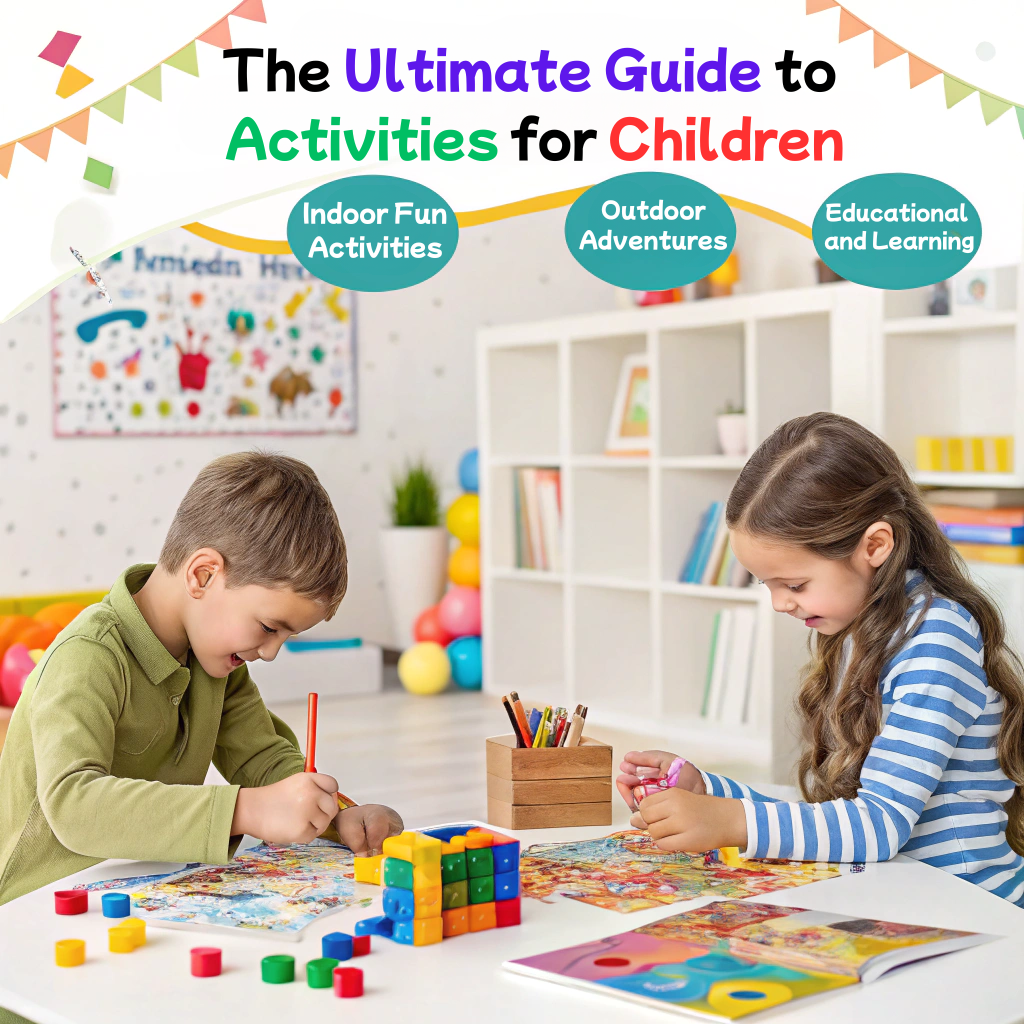As parents, caregivers, or educators, finding exciting and educational activities for children can be a challenge. Whether you’re looking to spark creativity, improve physical skills, or simply keep kids entertained, there are endless possibilities to explore. This guide is here to help! Packed with fun, interactive, and developmentally appropriate ideas, it offers something for every child, no matter their interests or age. Let’s dive into some fantastic activities that will keep children engaged, learning, and having a blast!
1. Indoor Fun Activities for Children’s Creativity
When the weather keeps kids indoors or if you’re looking for a quiet afternoon at home, creative play is an excellent way to keep children entertained. Here are some ideas:
Arts and Crafts Ideas for Kids
Kids love to express themselves through painting, drawing, and crafting. You can set up a mini art station with supplies like markers, crayons, glue, and construction paper. Activities such as making collages, building models with clay, or decorating picture frames can provide hours of fun and allow children to explore their creativity.
DIY Science Activities for Children
For a fun way to introduce children to science, try simple experiments that they can easily participate in. Activities like creating a volcano eruption with baking soda and vinegar, making slime, or growing crystals are engaging and educational. These activities teach children the importance of observation, following instructions, and problem-solving.
Board Games and Puzzle Activities for Children
Board games are great for social interaction, teamwork, and cognitive development. Games like “Monopoly,” “Scrabble,” or “Connect Four” encourage strategic thinking and help children understand concepts like turn-taking, patience, and friendly competition. Puzzles, on the other hand, develop a child’s problem-solving and spatial skills.

2. Outdoor Adventures
When the weather is nice and the kids are ready to burn off some energy, outdoor activities are perfect for improving physical health, coordination, and social skills. Here are a few options to consider:
Fun Scavenger Hunt Activities for Kids
Scavenger hunts are a fantastic way to get children moving and exploring. Whether you’re in the backyard, at the park, or on a nature walk, create a list of items for children to find. You can tailor the difficulty of the hunt to the child’s age, making it as simple or challenging as needed. Scavenger hunts also help develop observational skills and can be made educational by including nature or color identification.
Sports and Physical Activities for Children
Teaching children the basics of a sport or simply playing a game of catch or tag can be a fun way to keep them active. Activities like soccer, basketball, or even simple games like hide and seek and red rover can help develop motor skills, hand-eye coordination, and teamwork. For younger children, setting up obstacle courses in the backyard can also be a fun physical challenge.
Nature Walks and Exploration Activities for Kids
Take the kids outdoors for nature walks or hikes, where they can observe animals, plants, and natural phenomena. Nature walks are not only great for physical exercise but also offer opportunities for learning. Bring a magnifying glass to explore leaves, insects, and other small details. You can also teach children about environmental conservation and the importance of protecting nature.
3. Educational and Learning Activities for Children
Learning doesn’t always need to take place in a classroom. Fun and educational activities can be integrated into daily routines, helping children absorb new information without even realizing it. Here are a few educational activities that children can enjoy:
Reading and Storytelling Activities for Kids
Reading books to children or encouraging them to read on their own is one of the best ways to stimulate their imagination and language development. Choose a variety of books based on the child’s age and interests, and make storytime interactive by asking questions about the characters and plot. Storytelling activities also encourage children to express themselves creatively and develop a love for literature.
STEM Learning Activities for Children
Science, technology, engineering, and math (STEM) activities can help children develop critical thinking and problem-solving skills. Hands-on projects like building simple machines with household items, learning about basic coding through online games, or even creating simple circuits using batteries and wires can inspire young minds to think analytically.
Educational Apps and Digital Learning Games for Children
In the digital age, there are countless apps and online resources that combine learning with entertainment. Many apps are designed to teach children subjects like math, reading, and even foreign languages through fun games and activities. Always make sure to select age-appropriate apps and limit screen time to ensure a healthy balance between digital learning and physical play.

4. Social and Group Activities for Children
Social skills are an essential part of child development. Encouraging activities that involve teamwork, communication, and cooperation will help children build lasting friendships and learn to work with others. Here are some ideas:
Group Play and Team Activities for Children
Engage children in group activities like charades, relay races, or group storytelling. These activities not only improve social interaction but also help kids practice empathy, turn-taking, and listening skills. Activities like group crafts or collaborative art projects also promote teamwork and creativity.
Playdate Activities for Socializing Kids
Organizing playdates with friends or family members allows children to practice sharing, resolving conflicts, and cooperating. Whether it’s building a fort, baking cookies together, or working on a shared art project, playdates help children develop a sense of belonging and learn how to navigate social dynamics in a fun setting.
Community Volunteer Activities for Kids
Older children can engage in volunteer work or community service projects. Helping out at a local food bank, organizing a charity drive, or assisting with community clean-up events can teach children about kindness, responsibility, and the importance of giving back to their community.
Conclusion :
The ultimate guide to activities for children offers a wide range of options that help promote physical, cognitive, emotional, and social development. Whether you’re stuck inside or enjoying the great outdoors, these activities provide children with the opportunity to have fun while learning and growing. From creative arts and crafts to educational games and sports, the key is to keep it varied and exciting to maintain a child’s interest. So, the next time you need an idea to keep the kids busy, you’ll have a whole range of fun, engaging activities to choose from!

